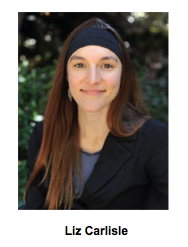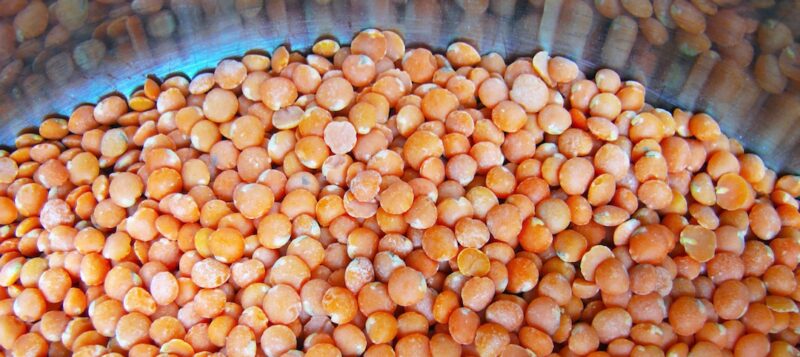Lentils are hardly a staple of the American diet. Long dismissed as “humble peasant food,” these legumes are produced in far smaller quantities than wheat and corn, says UC Berkeley geographer Liz Carlisle. Yet lentils are leading a “revolution” in the nation’s conservative grain belt, Carlisle argues, and they offer potentially vital lessons for drought-stricken California.
Carlisle, who completed her Ph.D. and is now a fellow at Berkeley’s Center for Diversified Farming Systems, recently published a book entitled Lentil Underground: Renegade Farmers and the Future of Food in America, which chronicles how a group of Montana farmers’ switch to lentils became “the keystone for a transition to organic agriculture” in the state.
Lentils are among the world’s oldest domesticated crops, first cultivated 10,000 years ago in the Fertile Crescent. A cheap, healthy source of protein, they are rich in fiber, folate, vitamin B, and amino acids. Just as importantly, they are drought tolerant, adapting their growth cycle to the amount of available water, and they can be grown without chemicals.
Most crops in the U.S. are farmed with synthetic nitrogen fertilizer, which generates 300 million metric tons of CO2 emissions per year, making it the largest culprit in the American food system in generating greenhouse gas emissions. Run-off from chemical fertilizer into the Mississippi River has created a “dead zone” in the Gulf of Mexico and is polluting the U.S. water supply.
As a legume, though, lentils make their own fertilizer, using bacteria in the soil to convert nitrogen from the air into plant-available forms. This nourishes the lentils, and also leaves residual fertilizer in the soil for the next crop. By incorporating lentils into a diversified crop rotation, Carlisle says, Montana farmers have been enriching the soil and keeping weeds at bay, all without using chemicals.
A native of Missoula, Montana, Carlisle first learned about farming from her grandmother, who grew up on a farm during the Dust Bowl. “The genesis of my interest in sustainable agriculture,” she says, “was being a tiny kid and Grandma telling me about all of the soil blowing away, because her dad didn’t know any better about how to take care of it.”
After graduating from Harvard, she had a brief career as a country singer, opening for LeAnn Rimes and other major acts. While touring in the Midwest, she heard from farmers who were struggling to survive in corporate agriculture. “I realized how massive the problems where, but I also wanted to tell a story about the solutions,” she says.
She went to work as a legislative aide for Jon Tester, an organic lentil farmer from Eastern Montana who had just been elected to the U.S. Senate. After hearing from other lentil farmers in her home state, she left Washington to study diversified farming issues at UC Berkeley, with intermittent stints conducting fieldwork on Montana farms.

In the 1970s, the U.S. government heavily promoted industrial farming, rewarding farmers for growing massive amounts of corn, soy, and wheat. At that time, Secretary of Agriculture Earl Butz urged farmers to plant “fencerow to fencerow.” The “zero tillage” policy encouraged farmers to abandon plowing in favor of weed-killing chemicals.
David Oien, the hero farmer of Lentil Underground, tried a different tactic. In the mid-70s, Oien, then 27, dropped out of graduate school to return to his family’s 280-acre farm and pursue organic farming methods. After beginning with a solar power retrofit, Oien became the first farmer in Conrad, Montana to grow lentils, opening his company, Timeless Seeds, in 1987. Initially selling 50-lb. bags to locals, Oien gradually partnered with other local farmers (including Tester) to create a retail line supplying major grocery store chains, including Whole Foods.
Rather than maximizing their yield in ideal conditions, lentil farmers like Oien have sought to build a system capable of weathering hard times. It seems to be working: in 2012, a historic drought year, Timeless Seeds experienced zero losses, thanks to crop rotations that have built up organic matter and moisture in the soil.
On the U.S. Drought Monitor Map, most of California is now colored scarlet, for “exceptional drought.” In April, Governor Jerry Brown ordered a 25 percent cut in water consumption for residents and businesses. But while public discussion centers on long showers and lawn watering, the heart of the issue is farming: agriculture accounts for 80 percent of the state’s water consumption.
More than a third of the country’s vegetables, and two-thirds of its fruit and nuts, are grown in California. Some crops are exported heavily overseas: for example, the state provides 82% of the world’s almonds. The Central Valley, which is home to the bulk of the state’s farms, relies heavily on irrigation. To compensate for falling state and federal water subsidies, farmers have dug ever-deeper wells, putting the state’s groundwater—which accounts for the majority of the water used for agriculture during drought years—at risk.
So in the fight to reduce water consumption, should California farmers turn to lentils? Not exactly, Carlisle says: the state is largely too hot for this particular legume, which fares poorly in temperatures above 85 degrees. Cool-season legumes such as winter peas and crimson clover, however, could perform a similar role to that of lentils in enriching the soil.
For California, lentils’ main value lies in demonstrating that “you don’t need a whole lot of water to farm,” Carlisle says. Industrial farming practices contribute to drought conditions by reducing soil’s water holding capacity over time, but dry farming could help reverse the tide. Even almonds, which have earned notoriety for their high water consumption, used to be grown without irrigation. “I think it would be possible to have a much more environmentally benign agriculture in California, if we were really planning for it that way,” she says.
Some California farmers have already stopped irrigating. Dry-farmed tomatoes have become a favorite among chefs thanks to their superior flavor, as tomatoes containing less water have a stronger taste. Other farms are growing crops like broccoli, squash, potatoes, and garlic without irrigation. There are also dry-farmed grapes, as at Condor’s Hope Vineyard.
Such farming requires a careful cycle of planting and tilling to retain soil moisture, as well as more space between plants, which develop deeper roots to find water. Timing is critical: if ground moisture from winter rainfall evaporates too quickly, there is no external water source to fall back on.
As a solution for addressing California’s water crisis, dry farming’s higher risks and lower yields make it less popular than other options, such as more efficient irrigation methods. Still, Carlisle says that organic farming can serve as “the foundation of our entire food system, not just a niche product.”
“It’s been just a short period of time that we’ve been experimenting with a chemically based agriculture rather than a biologically based one—about 70 years out of 10,000,” she says. “I think we’ll look back and see that as an anomaly.”
The outlook for lentils isn’t entirely rosy. According to Oien, the average consumption of lentils per year in the US is around 10 ounces per person, compared to 175 pounds of wheat (though when Timeless Seeds started, Americans averaged only 3 ounces). According to the most recent USDA statistics, in 2014 there were 259,000 acres of lentils harvested in the U.S., compared to over 46 million acres of wheat and 83.1 million acres of corn for grain.
Timeless Seeds now grows a variety of lentils, including petite crimson and caviar-like black beluga. But the company only contracts with 20 farmers. As of now, there simply is not enough consumption to justify many more farms incorporating lentils into crop rotation.
Ironically, the “locavore” movement has made the situation worse. As affluent Americans pledge to eat food that only comes from within a 100-mile radius, organic farmers in the Midwest find themselves with a sagging market for their crops. The emphasis on eating local is misplaced, Carlisle has noted, as transportation to sellers accounts for only four percent of greenhouse gas emissions associated with the American food system. Instead, she advocates domestic fair-trade partnerships to help connect urban consumers and low-income rural growers who farm without nitrogen.
On the bright side, Carlisle says, lentils are rising in popularity among chefs and home cooks, and are now being served in public school cafeterias (including in Montana) as part of the Farm to School movement. “For cash-strapped rural food districts, it’s a total godsend,” she says.
For her part, Carlisle says she has eaten her fair share of lentils, particularly on the Lentil Underground book tour this spring, which included a variety of cooking events. Her favorite recipe is the Ethiopian dish mesir wat, a spicy stew containing onions, lentils, and spices.
To avoid digestive issues, Carlisle recommends increasing lentil intake gradually, and soaking the legumes in water before cooking. Using traditional spice-based recipes is also a good idea. “We tend to think of spices as just for flavor and optional, sort of the icing on the cake, but they’re an important part of how we digest things,” she says.
Click here to see the official website for Lentil Underground.



